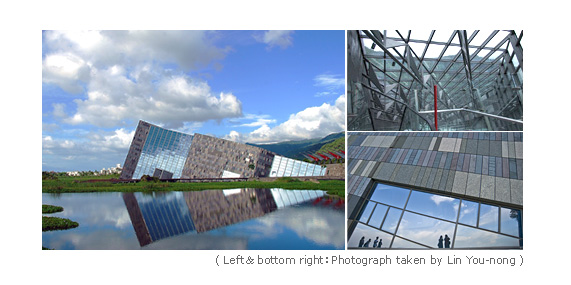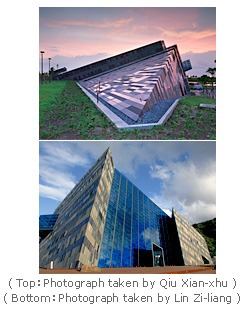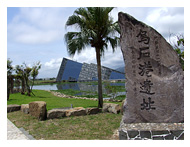
Architectural Landscape: The Cuesta Emerging from the Ground.
1.Unique Cuesta Style
An architectural team led by Mr. Yao Ren-xi was in charge of designing the museum. The building’s design is inspired by the cuestas commonly seen along the Beiguan Coast. Cuesta is a Spanish name for a geological formation in which rock layers gently slope up to an escarpment or a cliff and at this raised point the rock layers are exposed on their edges. These cuestas are unique geographical features of this region. The museum adopts the geometric shapes of the cuestas, the roof protrudes from the ground at an angle of 20 degrees meeting a wall which rises from the ground at an angle of 70 degrees. Thus the building emerges from the ground in a similar fashion to that of a cuesta, enabling it to blend in with the surrounding geological features.
2.Complementing the Rhythmic Vertical Surface with Musical Notes of the Four Seasons
Looking down on the beautiful Lanyang plain from above, one can see many rice fields of varying sizes, shapes and colors; different weather conditions and seasons cause these fields to change their lovely colors and shades. Mr. Yao Ren-xi has displayed musical notes on the four exterior walls of the main building. These notes are from the violin concerto of Vivaldi’s, The Four Seasons. The four movements of Spring, Summer, Autumn and Winter are represented by using stones of different textures. These stone notes use the dynamics of this classical music to illustrate the agricultural landscape of the Lanyang plain during the four seasons.

3.The Joints of Cuesta
The arrangements, combinations and divisions of the aluminum panels on the exterior walls mimics that of the rock joints of the cuesta, the aluminum panels are parallel with to the 20 degree angled roof, representing the cuesta’s layers of stones flowing downwards into the ground. When looked at from afar, the water absorbent darker colored stone cladding forms contrasts with the lighter color of the aluminum panels, similar to the contrasting hues in various stones layers of the cuesta which have been enhanced by the ocean’s erosion over a long period of time.
4.Symbiosis with the Environment
The ideals of “Symbiosis with the environment” and “Become one with nature” are incorporated into the museum’s building and surrounding area so it can be in harmony with the wetland ecology of the Wushi coast. This is the reason the main building, of the museum, is located at the northwest of the grounds. This preserves as large an area as possible of the original wetland ecological park.
Park Landscape: Wushi Harbor and historical surroundings

The Lanyang Museum is not limited to only the building; the surrounding area is also a natural part of the museum. Visitors can compare the wetlands of today with the bustling spectacle of the “Shigang Spring Sails” of ancient times. Meditating on the transformation of the area from its historical past will evoke a nostalgic feeling.
1.Cultural History
“Shigang Spring Sails” is located at what was Wushi Harbor and from there one can see a panoramic view of the wetlands, This makes it the ideal location to explain the history of Wushi Harbor and experience the past glory of the “Shigang Spring Sails”. The Wushi Coast Park has valuable cultural and historical significance. The remains of the Wushi Reef are situated at the base of the Lanyang Museum. During the Qing Dynasty the Wushi Harbor became famous due to the presence of three large black reefs in the harbor area. The harbor was a commercial hub for cargo ships entering and exiting Yilan, and the flourishing scenes of “Shigang Spring Sails” were one of the Eight Wonders of Lanyang. However, since the 19th century, earth, stone and silt have gradually filled the harbor channel. This combined with the opening of the Yilan railway, during the Japanese occupation, saw the end of Wushi Harbor and Toucheng as a bustling center for trade.
During the year 89 of the Republic of China (the year 2000), the Executive Yuan approved the construction of the Lanyang Museum at Wushi Harbor. In addition, the former site of Wushi Harbor was zoned as a cultural area and designated to be a park. Thus a tourism corridor has been formed linking the ocean park cultural facilities, the historical area of Toucheng’s old city district and the northeast coast national scenic area. This creates a display of Yilan’s present nature and ecology as well as its historical past.
2.Natural Texture
From the museum one can appreciate the natural environment of the surrounding area with its forest landscapes and wetland ecology. The areas “Turtle-watching from Wushi” and “Viewing Sunrise from Guishan” (please see the map of museum park: http://www.lym.gov.tw/eng/en_service_3.asp ) are located on the axis of Guishan Island; they are perfect locations for viewing Guishan Island in the distance. As for the Beiguan Tide (the entrance plaza), its design aesthetics also echo the architecture’s cuesta shape.












